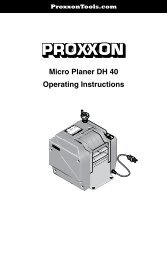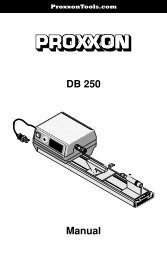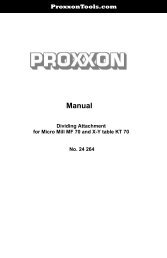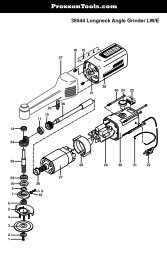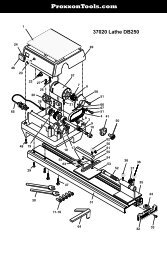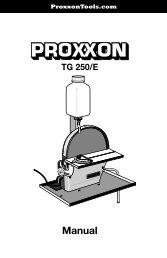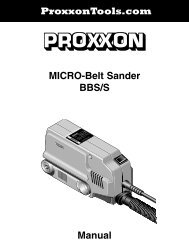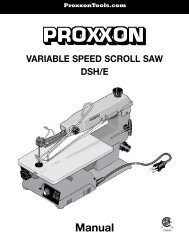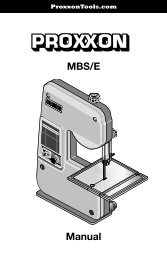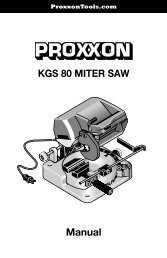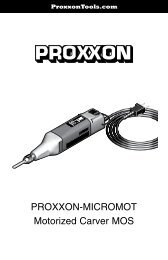MICRO Mill MF 70 Manual - Proxxon Tools
MICRO Mill MF 70 Manual - Proxxon Tools
MICRO Mill MF 70 Manual - Proxxon Tools
You also want an ePaper? Increase the reach of your titles
YUMPU automatically turns print PDFs into web optimized ePapers that Google loves.
Operating Instructions<br />
Micro <strong>Mill</strong>ing Machine <strong>MF</strong> <strong>70</strong><br />
Dear Customer,<br />
By purchasing your PROXXON Micro <strong>Mill</strong>ing Machine<br />
<strong>MF</strong> <strong>70</strong>, you have chosen a good-quality, high-grade<br />
machine. The PROXXON <strong>MF</strong> <strong>70</strong> <strong>MICRO</strong> <strong>Mill</strong>ing Machine is<br />
equipped with the proven KT <strong>70</strong> microcoordinate table.<br />
This enables you to perform small, precise milling operations<br />
on metal, plastics or wood. In order to operate the<br />
milling machine and the accompanying accessories safely<br />
and correctly, please read the enclosed safety information<br />
and operating instructions prior to operation.<br />
This instruction manual covers:<br />
• safety regulations<br />
• operation and maintenance<br />
• spare parts list<br />
Please read carefully!<br />
Using this instruction manual will<br />
• make it easier for you to get used to the machine,<br />
• help prevent faults occurring due to improper use and<br />
• increase the service life of your machine.<br />
Keep this instruction manual in an easily accessible place.<br />
Only operate this machine if you are qualified to do so<br />
and follow the guidelines in this instruction manual.<br />
PROXXON does not accept responsibility for the safe functioning<br />
of the machine<br />
• if it is handled in a manner which constitutes improper<br />
use,<br />
• if it is used for other purposes which are not specified<br />
in the instruction manual,<br />
• if the safety regulations are not observed.<br />
Warranty claims are invalid if<br />
• the machine is incorrectly operated,<br />
• the machine has not been sufficiently maintained.<br />
In the interests of your safety, please always observe the<br />
safety regulations.<br />
Only use genuine PROXXON spare parts.<br />
We reserve the right to make further alterations for the<br />
purpose of technical progress.<br />
We wish you every success with your machine.<br />
General safety instructions:<br />
1. REMOVE ADJUSTING KEYS AND WRENCHES. Form<br />
habit of checking to see that keys and adjusting wrenches<br />
are removed from tool before turning it on.<br />
2. KEEP WORK AREA CLEAN. Cluttered areas and benches<br />
invite accidents.<br />
3. DON'T USE IN DANGEROUS ENVIRONMENT. Don't<br />
use power tools in damp or wet locations, or expose<br />
them to rain. Keep work area well lighted.<br />
4. KEEP CHILDREN AWAY. All visitors should be kept safe<br />
distance from work area.<br />
5. MAKE WORKSHOP KID PROOF with padlocks, master<br />
switches, or by removing starter keys.<br />
6. DON'T FORCE TOOL. It will do the job better and safer<br />
at the rate for which it was designed.<br />
- 4 -<br />
7. USE RIGHT TOOL. Don't force tool or attachment to<br />
do a job for which it was not designed.<br />
8. USE PROPER EXTENSION CORD. Make sure your<br />
extension cord is in good condition. When using an<br />
extension cord, be sure to use one heavy enough to<br />
carry the current your product will draw. An undersized<br />
cord will cause a drop in line voltage resulting in<br />
loss of power and overheating. Table 1 shows the correct<br />
size to use depending on cord length and nameplate<br />
ampere rating. If in doubt, use the next heavier<br />
gage. The smaller the gage number, the heavier the<br />
cord.<br />
Exception No. 1: The reference to the table and the<br />
table itself may be omitted if a statement indicating<br />
the appropriate gage and length is incorporated into<br />
the instruction.<br />
Exception No. 2: The information regarding extension<br />
cords need not be provided for a permanently<br />
connected tool.<br />
9. WEAR PROPER APPAREL. Do not wear loose clothing,<br />
gloves, neckties, rings, bracelets, or other jewelry<br />
which may get caught in moving parts. Non-slip<br />
footwear is recommended. Wear protective hair covering<br />
to contain long hair.<br />
Exception: The reference to gloves may be omitted<br />
from the instructions for a grinder.<br />
10. ALWAYS USE SAFETY GLASSES. Also use face or<br />
dust mask if cutting operation is dusty. Everyday<br />
eyeglasses only have impact resistant lenses, they are<br />
NOT safety glasses.<br />
11. SECURE WORK. Use clamps or a vise to hold work<br />
when practical. It's safer than using your hand and it<br />
frees both hands to operate tool.<br />
12. DON'T OVERREACH. Keep proper footing and<br />
balance at all times.<br />
13. MAINTAIN TOOLS WITH CARE. Keep tools sharp and<br />
clean for best and safest performance. Follow instructions<br />
for lubricating and changing accessories.<br />
14. DISCONNECT TOOLS before servicing; when changing<br />
accessories, such as blades, bits, cutters, and<br />
the like.<br />
15. REDUCE THE RISK OF UNINTENTIONAL STARTING.<br />
Make sure switch is in off position before plugging in.<br />
16. USE RECOMMENDED ACCESSORIES. Consult the<br />
owner's manual for recommended accessories. The<br />
use of improper accessories may cause risk of injury<br />
to persons.<br />
17. NEVER STAND ON TOOL. Serious injury could occur if<br />
the tool is tipped or if the cutting tool is unintentionally<br />
contacted.<br />
18. CHECK DAMAGED PARTS. Before further use of the<br />
tool, a guard or other part that is damaged should be<br />
carefully checked to determine that it will operate properly<br />
and perform its intended function -- check for<br />
alignment of moving parts, binding of moving parts,<br />
breakage of parts, mounting, and any other conditions<br />
that may affect its operation.<br />
A guard or other part that is damaged should be properly<br />
repaired or replaced.<br />
19. DIRECTION OF FEED. Feed work into a blade or cutter<br />
against the direction of rotation of the blade or<br />
cutter only.<br />
20. NEVER LEAVE TOOL RUNNING UNATTENDED. TURN<br />
POWER OFF. Don't leave tool until it comes to a complete<br />
stop.



